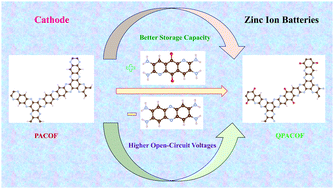Tuning the structural skeleton of a phenanthroline-based covalent organic framework for better electrochemical performance as a cathode material for Zn-ion batteries: a theoretical exploration†
Abstract
Rechargeable zinc ion batteries (ZIBs) have received significant attention from the scientific community as an alternative to lithium ion batteries (LIBs) for large-scale energy storage systems owing to their high safety and low cost. However, the lack of a suitable cathode material limits their practical implementation. By using density functional theory (DFT)-based computations, we have herein investigated the electronic structure of a very recently synthesized phenanthroline-based covalent organic framework (PACOF) to lend support for its applicability as a promising cathode material for ZIBs. We have analyzed the diffusion barriers, open-circuit voltages (OCVs), and storage capacity of this COF. Thereafter, inspired by some very recent experimental research works, we have predicted a new framework based on quinone and phenanthroline (QPACOF), which is found to exhibit better electrochemical performance as a cathode material for ZIBs compared with PACOF. Our predicted framework (QPACOF) exhibits almost twice the storage capacity shown by PACOF. Moreover, the OCVs of QPACOF are higher than that of PACOF, ensuring a larger cell voltage for QPACOF. Finally, we have proposed a possible synthetic route to experimentally synthesize our predicted model system (QPACOF).



 Please wait while we load your content...
Please wait while we load your content...